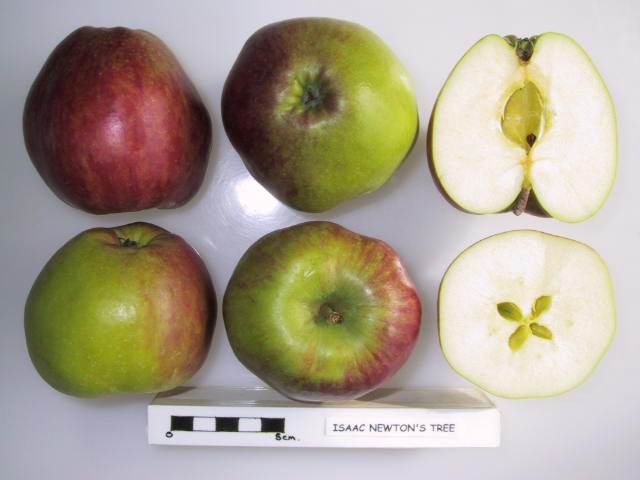The fall of an apple, historical records suggests, did set Isaac's Newton's mind to work on the problem of gravity.

|
There is no evidence, however, that fruit met noggin.
The pomological record on the presumed apple, Flower of Kent, is murkier. Let's take these in order.
Why didn't the apple fall far from the tree?
After dinner, the weather being warm, we went into the garden and drank thea, under the shade of some apple trees…he told me, he was just in the same situation, as when formerly, the notion of gravitation came into his mind.
It was occasion’d by the fall of an apple, as he sat in contemplative mood. Why should that apple always descend perpendicularly to the ground, thought he to himself….
The apple engaged Sir Isaac's intellect, but not, as far as we know, his cranium.
Stukeley's holographic work has been digitized by the Royal Society and can be read online. The apple story appears on page 15.
Is that our apple?

|
| Flower of Kent |
The location of Newton's apple tree is known. It grew, and indeed till survives (but see rerooting, below), at the site of his family's estate in in Lincolnshire.
Newton had repaired there from Cambridge in 1665 following an outbreak of the bubonic plague. Orange Pippin tells us
since it was the only apple tree in the garden, it was possible to identify the specific variety: it is an old English apple called Flower of Kent.
But is it the Flower of Kent? The National Fruit Collection (UK) lists this apple as "Isaac Newton's Tree" and only says the variety "appears identical to Flower of Kent."
"Appears identical" suggests some doubt.
Rerooting
According to some sources, Flower of Kent was a cultivar dating from the 16th century. A cultivar is a cultivated variety, so the Lincolnshire tree would have been produced by grafting, in which budwood is grafted onto rootstock.
Probably, the rerooted branch would have been from the budwood part of the tree—the Flower-of-Kent part. But it could have been from the rootstock.
If so, grafts from the rerooted tree would not bear the same apple as the original tree.
Whatever it is, have I got the right apple? It does not look the same as the one from the NFC (which the NFC forbears from actually calling Flower of Kent):

|
| Open Government License (UK) |
Note the tapered shape and recessed calyx at the bottom. My samples were round with projecting calyx ends.
The NFC also gives the harvest time as mid-October. However, my apples, picked a few days before the September equinox, are quite ripe.
The coloring and the ribbing are right enough, though. (Redder red on mine because of direct sunshine.)
Newton's apple tree, from the Lincolnshire estate, has been grafted multiple times. It grows in gardens near the physics departments of many colleges and universities.

Very interesting! Looking at the NFC database entry for 'Isaac Newton's Tree' (http://www.nationalfruitcollection.org.uk/full2.php?id=2946&&fruit=apple) I see it has an 'SSC' mark, which means it was genetically tested between 2006-2010 and found to be distinct from anything else in the collection.
ReplyDeleteBut 'Flower of Kent' is just listed, with no additional info in the database, which I think means it's not in the National Collection and so hasn't been tested.
Sounds to me like they're saying - as you suggested - that it's not necessarily the same apple, but they can't say for sure.
Parkinson's Paradisi in Sole Paradisus Terrestris (1629) says "The Flower of Kent is a faire yellowish greene apple both good and great" which doesn't sound like the current version.
And it's not conclusive, but there's no mention of 'Flower of Kent' as being a well-known variety in John Worlidge's 'Vinetum Britannicum (1672)' but he is mainly interested in apples for cider production. He does talk about 'Kentish Pippins' of "several sorts" though, and if there was only one tree in Newton's garden, that could mean it was a chance seedling / pippin, rather than part of a larger orchard?
Intriguing!
Thank you, @Unknown! All news to me, including the "SCC" signifier.
DeleteNB "Unknown" has upgraded his handle to "Darren T." Nice to have a name for you!
Delete